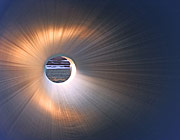The proper performance of a hydraulic system is usually attributed to major components such as the motor, pump and valves. However, there is another unsung component that contributes equally to a system's overall performance: the orifice. In most traditional main hydraulic valves, orifices are built into the casting or dismounting components mold by the component’s constructors. In a cartridge valve manifold (otherwise known as a hydraulic integrated circuit), you start with a blank sheet of paper. Therefore, it is important to know where and when an orifice can change the performance of your system. |
|
The orifice is one of the most versatile components that we can add in our hydraulic circuit. The orifice can be used to limit the amount of oil in one part of our system, to bleed a pressure line to tank, or to transform a nervous and aggressive circuit into an efficient and highly controlled one. Often times the orifice has to simultaneously manage a very small amount of oil, control a dynamic flow rate and dump a system’s compensator. In many applications -- especially for hydrostatic transmissions -- it is important to control the dynamic pressure of the system to avoid pressure spikes and pressure ripple.





